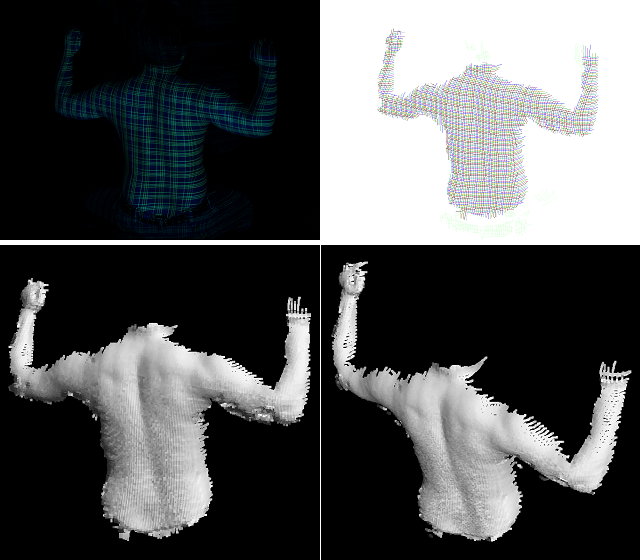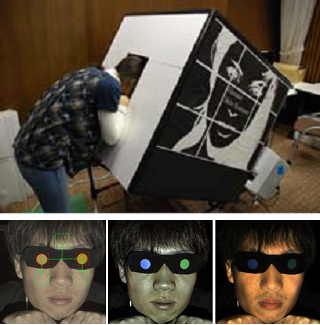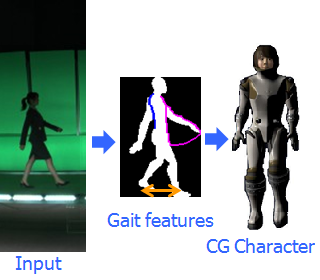Human Sensing
Measurement of from entire body to subcutaneous structure
Dense 3D reconstruction method using a single pattern for fast moving object
|
 |
Dense 3D reconstruction of extremely fast moving objects could contribute to various applications such as body structure analysis and accident avoidance and so on. The actual cases for scanning we assume are, for example, acquiring sequential shape at the moment when an object explodes, or observing fast rotating turbine’s blades. In this paper, we propose such a technique based on a one-shot scanning method that reconstructs 3D shape from a single image where dense and simple pattern are projected onto an object. To realize dense 3D reconstruction from a single image, there are several issues to be solved; e.g. instability derived from using multiple colors, and difficulty on detecting dense pattern because of influence of object color and texture compression. This paper describes the solutions of the issues by combining two methods, that is (1) an efficient line detection technique based on de Bruijn sequence and belief propagation, and (2) an extension of shape from intersections of lines method. As a result, a scanning system that can capture an object in fast motion has been actually developed by using a high-speed camera. In the experiments, the proposed method successfully captured the sequence of dense shapes of an exploding balloon, and a breaking ceramic dish at 300-1000 fps.
|
- Publications
-
Hiroshi Kawasaki, Ryo Furukawa, Ryusuke Sagawa, Yuya Ohta, Kazuhiro Sakashita, Ryota Zushi, Yasushi Yagi, Naoki Asada, "Linear solution for oneshot active 3D reconstruction using two projectors", In In Proc. Fifth International Symposium on 3D Data Processing, Visualization and Transmission, Paris, May, 2010.
-
Ryusuke Sagawa, Yuya Ohta, Yasushi Yagi, Ryo Furukawa, Naoki Asada, Hiroshi Kawasaki, "Dense 3D Reconstruction Method Using a Single Pattern for Fast Moving Object", In Proc. 2009 IEEE 12th International Conference on Computer Vision, pp.1779--1786, Kyoto, Sep., 2009.
|
Facial Skin Measurement
|
 |
The characteristic of human skin depends on the age and gender. In this paper, we statistically analyze skin characteristics based on the large-scale database of about 1000 people in a wide age range to find the differences of skin characteristics in personality. Since skin is translucent, the incident ray on the skin surface is divided into reflection and scattering. That is, some rays reflect on the surface while the other rays scatter into the media. In our method, we first acquire reflection component and scattering component from facial images. Translucency of skin is analyzed by calculating the proportion of both components. Then, reflection component is divided into diffuse reflection and specular reflection. We analyze how oily the skin is by calculating the specular strength. Facial images among people over all ages were taken with measurement system including three projectors and two cameras. The characteristic of the facial image is calculated and the skin characteristic which depends on the age and gender is statistically analyzed.
|
Online Gait Measurement for Ditigal Entertainment
|
 |
This paper presents a method to measure online the gait features from the gait silhouette images and reflect the gait features to CG characters for an audience-participation digital entertainment. First, both static and dynamic gait features are extracted from the silhouette images captured by the online gait measurement system with two cameras and a chroma-key background. Then, Standard Gait Models (SGMs) with various types of gait features are constructed and stored, which are composed of a pair of CG characters’ rendering parameters and synthesized silhouette images. Finally, blend ratios of the SGMs are estimated to minimize gait feature errors between the blended model and the online measurement. In an experiment, a gait database with 100 subjects is used for gait feature analysis and it is confirmed that the measured gait features are reflected to the CG character effectually.
|
- Publications
-
M. Okumura, Y. Makihara, S. Nakamura, S. Morishima, and Y. Yagi,
``The Online Gait Measurement for the Audience-Participant Digital Entertainment,''
Proc. of Invited Workshop on Vision Based Human Modeling and Synthesis in Motion and Expression, Xi'an, China, Sep. 2009. [PDF]
- S. Nakamura, M. Shiraishi, S. Morishima, M. Okumura, Y. Makihara, and Y. Yagi,
``Characteristic Gait Animation Synthesis from Single View Silhouette,''
Proc. of SIGGRAPH 2009 (Poster), New Orieans, Louisiana, USA, Aug. 2009. [PDF]
|


